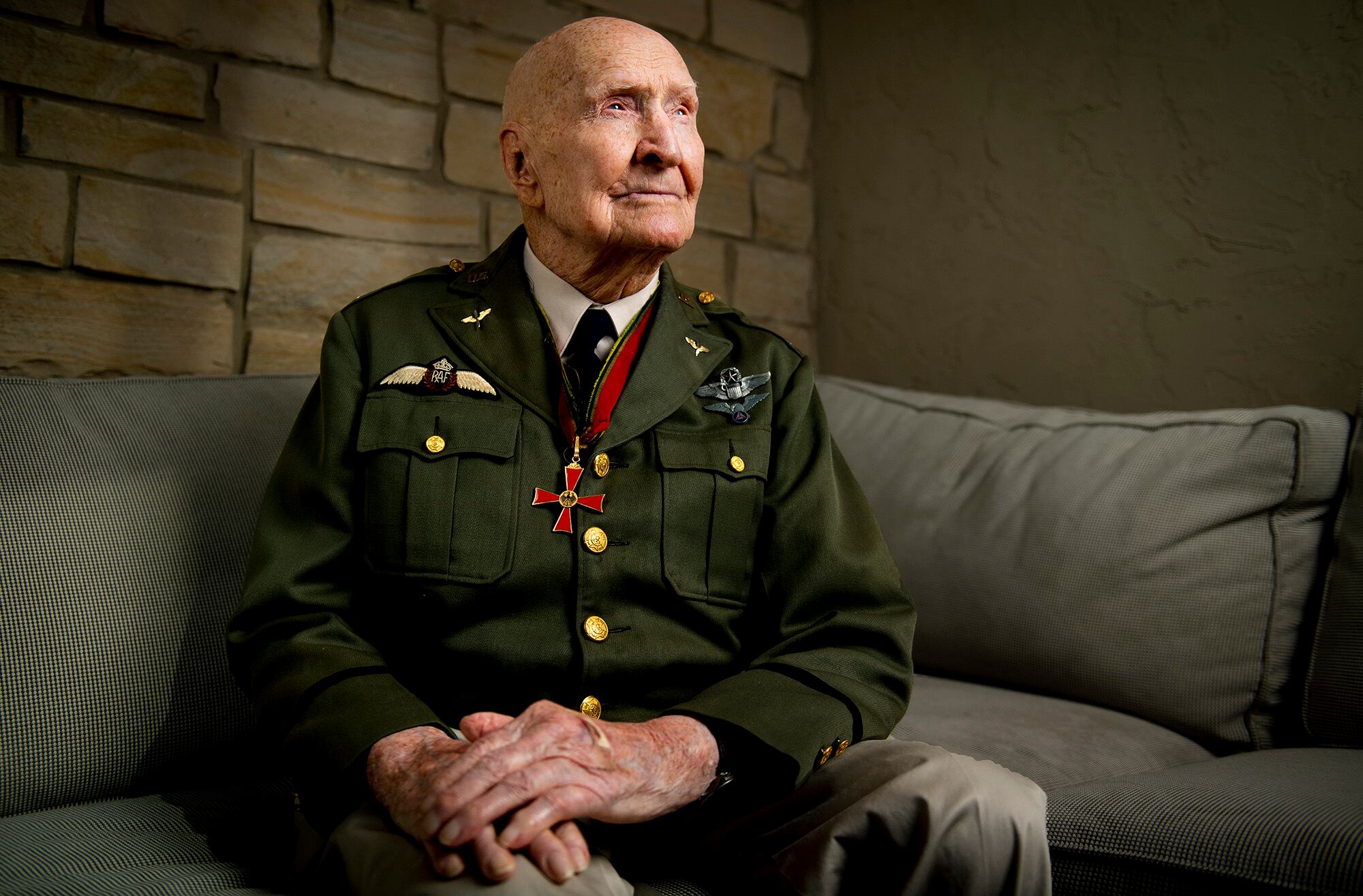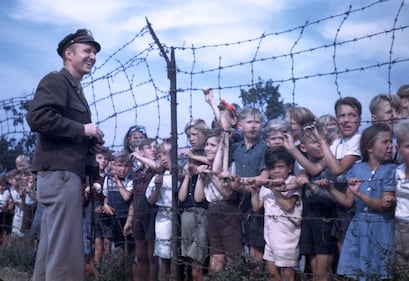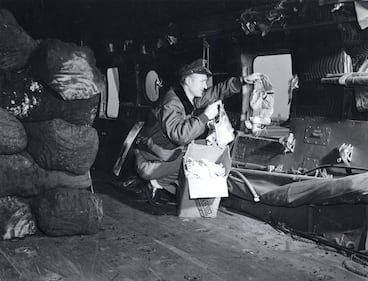A group of veterans and others are rallying support for a campaign urging the White House to bestow the Presidential Medal of Freedom on a pilot who flew humanitarian missions over Soviet-controlled East Germany during the beginnings of the Cold War.
Col. Gail S. “Hal” Halvorsen, also known as the Berlin Candy Bomber, delivered food and other goods to West Berlin during 1948-1949 as the Soviet Union worked to consolidate its hold on eastern Germany.
“He literally helped bind U.S. and German relationships after World War II because he made it about the kids and captured the heart of the American people,” said Duncan McNabb, a retired four-star general and former commander of Air Mobility Command and U.S. Transportation Command, in an email to Military Times.
A petition on the White House website calls for the president to award the medal on Halvorsen, who turned 100 last month.
“I can’t believe it,” Halvorsen told Military Times on a Tuesday evening phone call. “It’s just beyond my imagination if I were to receive an award from the head man of the government.”
The Medal of Freedom was established by President John F. Kennedy in 1963 and is the nation’s highest honor bestowed on civilians. The medal is awarded to those who make especially meritorious contributions to either “security or national interests of the United States,” “world peace” or “cultural or other significant public or private endeavors.”
“Col Halvorsen’s accomplishments throughout his life encompasses all of these areas,” the petition reads. “With this petition, we are requesting the White House consider Col Halvorsen for the Presidential Medal of Freedom as soon as possible to honor this extraordinary man.”
As of Wednesday, the petition had less than 1,500 signatures with a total of 100,000 signatures needed by Nov. 22 for a response from the White House.
Despite the low number of signatures on this petition, organizers of the effort say some 35,000 signatures were collected separately last spring.
RELATED

Air Force veteran Geno Carvotta submitted this most recent package to the White House and told Military Times in a Monday email he has received a response. A letter which appears to have been autosigned by President Donald Trump dated Oct. 22 acknowledged receipt of the package.
“I have known Col. Halvorsen for 25 years and I am trying to get this honor bestowed on him as soon as possible, which was why I decided a White House petition needed to be started to keep the momentum going,” Carvotta wrote.
Though the White House has confirmed receipt, Carvotta said it is still important people sign the petition and that when doing so must click on the activation link subsequently emailed from the White House to have their signature counted.
“While this nomination has the attention of the White House, having the petition reach its goal of 100,000 signatures will force the Administration to address the petition and hopefully send a message that this Humanitarian is deserving of this honor,” Carvotta wrote in an email. "This is no clearer message than having all these people support this effort with their support and signatures.
Carvotta, a retired Air Force master sergeant, said it was after the Airlift/Tanker Association convention last year when he decided to take action and get the medal for Halvorsen. Carvotta reached out to Col. Jim Stewart, executive director of the Gail S. Halvorsen Aviation Education Foundation, for help. Stewart informed him that the governor of Utah had previously submitted a similar request.
“With the current political climate, we are asking that people put politics aside and support the PMoF for Col. Halvorsen regardless of who the President is now or in the future,” Carvotta wrote. “This initiative is about honoring the Berlin Candy Bomber and the wonderful man and humanitarian he is.”
Image 0 of 4
Delivering smiles, not ordnance
Barbed wire separated Col. Gail Halvorsen from a group of about 30 children, who were excited to see him. They huddled up on him as best they could, gripping the twisted wire and peering at him through the manmade border at the Tempelhof Airport in Berlin.
It was July 1948 and a Berlin blockade enforced by the Soviets during the previous month had starved the children of Berlin and their families of much-needed supplies from Western Allies. Following World War II, the Soviet Union had annexed about a third of eastern Germany. Berlin, located in the middle of the Soviet-controlled region, was split in half, with the west holding its own for democracy. The communists controlled the east and choked out all western allied access by land and water.
All roads, railways and waterways going into West Berlin were tightly controlled by Soviet forces and the sky was the only viable avenue into the democratic section of the city.
In that moment, the barbed wire fence and the expressions on the children’s faces were a stark reminder of that reality.
Halvorsen, a C-54 Skymaster airlift pilot, was impressed with the resolve of those outspoken children in the group. They cautioned him not to land if the weather got too bad, willing to forego flour for freedom, Halvorsen said. “Just don’t give up on us,” he recalled them saying.
Halvorsen pulled out two sticks of gum — all he had on him — and split them in two. He passed them through the fence. The children who had a piece of gum began tearing off strips of the wrapper and passed them around. The children pressed the shreds of gum wrapper to their noses for the lingering scent.
He was so moved by what he saw that he promised the kids he would drop enough gum for each of them the next day. They would know his plane because he would “wiggle” the wings as he flew over the airport, Halvorsen said.
Halvorsen enlisted the help of his co-pilot and engineer to gather up candy from their rations that night. The next day, Halvorsen attached the gum and chocolate bars to three handkerchief parachutes.
“Somehow there’s something magical about a candy bar coming out of the sky over getting it over-the-counter at a drug store,” Halvorsen said.
As the crew flew over the children, Halvorsen manipulated the rudders to dip the wings of the plane left and right a few times before dropping the sugary goods.
“It was easy to do and an obvious signal that I had the stuff and it was about to drop,” Halvorsen said. “They ran after it like they never had any candy. Kids love to see parachutes come out … running around like mad trying to catch parachute.”
After landing, a lot of the kids would hang around for up to an hour talking to Halvorsen about his work, he said. They were fascinated with the workings of his plane.
“They got a kick out of that,” especially because it concerned what they might be having for dinner that night, Halvorsen said.
The kids didn’t know English, but Halvorsen knew just enough German to get by, he said. He’d keep a German phrase book on him and practice at night.
For several weeks, Halvorsen and a handful of other pilots dropped candy goods on the children of West Berlin before they were finally caught by their command. Halvorsen knew he should have requested permission first but was unsure of how long it would take for him to get the go-ahead. Halvorsen was compelled by the children’s desperate faces and had to act, he said.
The pilots could have faced court martial but were quickly pardoned, Halvorsen said.
“General Tunner said, ‘Keep it up and keep me informed,’” Halvorsen said.
Gen. William Tunner, then commanding general of the Atlantic Division of the Military Air Transport Command, saw this as an asset to the Berlin airlift resupply efforts and he signed off on the mission, dubbing it “Operation Little Vittles.”
“Oh boy, I came right off the floor,” Halvorsen said. “He could have court marshalled me, throwing stuff out of an airplane without permission.”
News spread and Americans lent their support for the Candy Bomber. The American Confectioners Association reportedly donated 18 tons of candy which was first sent to school children in Chicopee, Massachusetts, who attached little parachutes before sending it off to Berlin.
“I took a few chances,” said Halvorsen when asked if he’d have done anything differently. “I was pretty sure there’d be a good reaction. I wasn’t sure, but I think I would have done the same thing.”
Jared is the manager of print design for Sightline Media Group's five magazines under the Military Times and Defense News banners.








